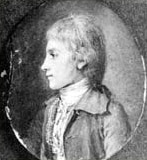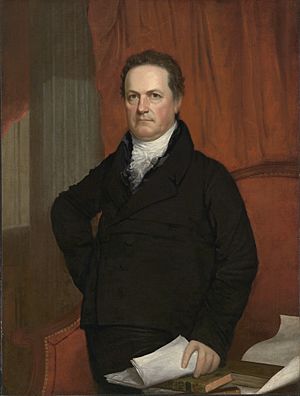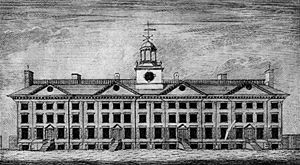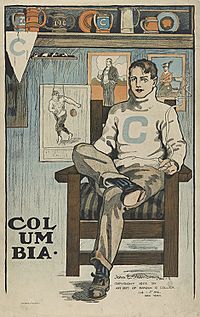History of Columbia University facts for kids

The history of Columbia University began even before it was officially started in 1754. It was first known as King's College in New York City. King George II of Great Britain gave it a special document called a royal charter to begin. It is the oldest college in the state of New York and the fifth oldest in the whole United States.
Contents
Starting King's College
Before the college was founded, there was a lot of debate. Different groups argued about where it should be built and which religion it should be connected to. Everyone agreed it should be in New York City. The Church of England won the debate about religion. However, they all promised to allow religious freedom for the college's rules.
Even though New York City became English in 1674, serious talks about starting a university didn't begin until the early 1700s. It was hard to start a college because people in the area spoke many languages and had different religions. Colleges back then were seen as religious places, not just for learning. For example, Harvard University started only six years after Boston, Massachusetts, a city with mostly Puritan people.
Talks about a college in the Province of New York began in 1704. Colonel Lewis Morris wrote to a Church of England missionary group, saying New York City was perfect for a college. But nothing happened for almost 50 years. Other colleges like Harvard (1636) and Yale (1701) had already started. Then, in 1745, New Jersey announced it would start the College of New Jersey (now Princeton University). This made New Yorkers realize they needed their own college quickly.
In 1746, New York's government decided to raise money for a new college using a public lottery. They collected £2,250, even though they didn't know what religion the college would be or where it would be built. In 1751, a group of ten New Yorkers was chosen to manage these funds. Most of them were Church of England members. Many rich people also gave money, including some who were involved in the slave trade.
In 1752, Trinity Church offered six acres of its land for the college. This solved the location problem. But William Livingston and others argued that the college should not be tied to one religion. Despite their objections, the group voted to accept the land, agreeing the college would be linked to the Church of England. They chose Dr. Samuel Johnson as the first president. He was a very smart scholar from The University of Oxford.
King's College (1754–1784)
Classes at King's College began in July 1754. There was a delay because it was hard to find enough teachers. Dr. Johnson was the only teacher for the first class, which had only eight students. They held classes in a new schoolhouse next to Trinity Church in Manhattan.
The college officially opened on October 31, 1754, as King's College. King George II of Great Britain gave it a special charter. This made it the oldest college in New York State and the fifth oldest in the U.S. In 1760, King's College moved to its own building near today's City Hall. In 1767, it started the first American medical school to give out the M.D. degree.
There was some disagreement about the new college. It was strongly connected to the Church of England and had a lot of influence from British officials. People worried that the British government would gain too much power in America through King's College. This college also had a lot of money, more than other colleges at the time.

In 1763, Myles Cooper became the new president. He was a strong supporter of the British King. One of his main opponents in college discussions was a student named Alexander Hamilton. Once, a crowd came to the college wanting to harm President Cooper. But Hamilton spoke to them, giving Cooper time to escape. The next year, the American Revolution began, and the college became a military hospital and barracks.
The American Revolution was very bad for King's College. It stopped teaching for eight years, starting in 1776. The college building was used as a hospital by both American and British soldiers. Its library was also robbed. Even though the college was seen as loyal to the British, many important American leaders came from King's College. These included:
- John Jay, who helped end the Revolutionary War. He later became the first Chief Justice of the United States.
- Alexander Hamilton, who helped George Washington and became the first Secretary of the Treasury.
- Gouverneur Morris, who wrote the final version of the U.S. Constitution.
- Robert R. Livingston, who helped write the Declaration of Independence.
- Egbert Benson, who represented New York in important meetings.
After the Revolutionary War (1784–1800)
Columbia College Under New Leadership

After the war, King's College had been closed for eight years. Many of its leaders were gone or had died. The college asked the State of New York for help. The state agreed, and on May 1, 1784, they passed a law. This law created a group called the Board of Regents to help restart King's College. They could hire a president and teachers, but they couldn't make teachers take any religious tests. To show support for the new country, the law also said that King's College would now be called Columbia College.
The Regents quickly started to rebuild. They asked for the college's books and other items back. They also hired William Cochran to teach Greek and Latin. In the summer of 1784, a war hero, Major General James Clinton, brought his son DeWitt Clinton to New York. DeWitt was planning to go to another college. But James Duane, the Mayor of New York and a Regent, convinced Cochran to let DeWitt join Columbia. DeWitt Clinton became one of the first nine students at the new Columbia College.
During this time, the Regents tried to make the college stronger. They planned to divide it into four main areas: Arts, Divinity, Medicine, and Law. Many different teaching positions were created. However, the college didn't have enough money to pay a president. So, different professors shared the president's duties, which caused some problems.
In 1787, the Regents realized the college needed a better plan. John Jay and Alexander Hamilton led a group to fix this. In April 1787, a new plan was approved. This plan, still used today, gave power to a private group of 24 Trustees.
Columbia College Continues to Grow
On May 21, 1787, William Samuel Johnson, the son of the first president, was chosen as the new President of Columbia College. He had been important in the Constitutional Convention that created the U.S. Constitution.
In the 1790s, Columbia grew stronger. New York City was the capital of the new United States of America. Important leaders like Hamilton and Jay supported the college. Even President George Washington and Vice President John Adams attended the college's graduation in 1789. They honored the many Columbia graduates who helped the U.S. become independent.
During Johnson's time, the college campus got bigger. In 1792, a new library building was added with help from New York State. In 1793, James Kent became the first law professor at any American university. This was the start of Columbia's Law School. In 1800, Dr. Johnson retired. The next president, Charles Henry Wharton, resigned shortly after being appointed.
Challenges and Changes (1800–1857)
Even though Columbia welcomed different religions and groups, the college struggled financially for many years. It didn't have enough money or support.
In the early 1800s, the college mainly focused on studying classics (ancient Greek and Latin). To get in, students needed to know Greek, Latin, and basic math. In 1810, the college made its admission rules stricter. Still, more qualified students joined, with 135 students in 1810. Before that, only about 17 students graduated each year.
Columbia didn't have sports teams back then. Student life mostly revolved around literary groups, like the Philolexian Society, started in 1802. In 1811, a new president, William Harris, saw a "Riotous Commencement." Students protested loudly because a student was not given a degree for putting bad words in his speech.
The main college building was old and looked bad. However, the college's money slowly grew because of its land investments. The true value of some of this land wasn't known until much later. For example, in 1814, New York State gave Columbia the Elgin Botanic Garden. This was a 20-acre piece of land that had been a private botanical garden. Columbia later leased this land to John D. Rockefeller Jr. in the 1920s to build Rockefeller Center. Columbia owned this land until 1985, when it sold it for $400 million.
In 1813, Columbia's medical school joined with another school to form the Columbia University College of Physicians and Surgeons. In the 1820s, the college improved its campus and slowly added more subjects, like Italian courses in 1825.
For the next 40 years, Columbia's student numbers, structure, and academics didn't change much. Many presidents did little to improve things. In 1831, Columbia faced competition from the University of the City of New York (now New York University). This new university offered more practical subjects, unlike Columbia's focus on old literature. NYU quickly became popular, having 158 students in its second year, while Columbia, after 80 years, only had 120. Columbia's leaders tried to stop NYU from opening, as Columbia was still struggling financially. By 1854, a newspaper noted that Columbia was "good in classics" but "weak in sciences" and had "very few distinguished graduates."
When Charles King became president in 1849, Columbia was in debt. Its land investments, especially the Botanical Garden, became a main source of steady money as New York City grew fast.
Moving and Growing (1857–1896)
In 1857, Columbia College moved to a new campus at 49th Street and Madison Avenue. The buildings were in the Gothic Revival style. It stayed there for 50 years. This move brought a new way of thinking for the college. President Charles King announced that Columbia was now "a university."
In the late 1800s, under President F.A.P. Barnard, the school quickly became a modern university.
- Columbia Law School started in 1858.
- The Columbia School of Mines (now the Fu Foundation School of Engineering and Applied Science) opened in 1864. It was the first school of its kind in the country.
- Barnard College for women, named after President Barnard, was created in 1889.
- The College of Physicians and Surgeons joined the university in 1891.
- Teachers College, Columbia University joined in 1893.
- The first PhD degrees were given out in 1875.
During this time, Columbia also started playing intercollegiate sports. The baseball team began in 1867, football in 1870, and a crew (rowing) team by 1873. The first Columbia football game was a 6–3 loss to Rutgers. The student newspaper, Columbia Daily Spectator, started in 1877.
Morningside Heights (1896–Present)
In 1896, the leaders officially changed the name to Columbia University. Today, it is known as "Columbia University in the City of New York." The engineering school also got a new name. At the same time, university president Seth Low moved the campus again. It moved from 49th Street to its current, larger location in Morningside Heights. This area was more rural back then. The land used to be a mental asylum. One of the asylum's old buildings, called Buell Hall, is still there today.
The most famous building at Columbia's Morningside Heights campus is Low Memorial Library. Built in 1895, it's still called "Low Library" even though it hasn't been a library since 1934. It now holds the offices of the President and other important university leaders. It looks like the ancient Pantheon in Rome and has the largest all-granite dome in the U.S.
Under President Nicholas Murray Butler, Columbia quickly became a leading research university. It set the example for how modern universities would be organized. Butler was president for over 40 years and was a very important person in American public life. He helped make the university run more like a business, which led to many new ways of organizing academic and administrative tasks.
In 1893, the Columbia University Press was founded to publish books on many subjects, including history, science, and literature. It publishes The Columbia Encyclopedia and The Columbia Lippincott Gazetteer of the World. In 1902, newspaper owner Joseph Pulitzer gave a lot of money to the university to start a journalism school. This led to the opening of the Graduate School of Journalism in 1912. It's the only journalism school in the Ivy League. This school also gives out the famous Pulitzer Prize.
In 1904, Columbia started offering adult education classes. These classes later led to the Columbia Writing Program, the Columbia Business School, and the School of Dentistry.
In 1928, Seth Low Junior College was created by Columbia. It was meant to help with the number of Jewish students applying to Columbia College. This college closed in 1938 because of the Great Depression.
An evening school, called University Extension, offered night classes for a fee. In 1947, this program became the School of General Studies. This was to help soldiers returning from World War II. In 1995, it became a full college for students who had taken a break from school. It was fully included in Columbia's regular undergraduate programs. At the same time, the School of Professional Studies was created to offer non-degree programs and later, various degree programs.
By the late 1930s, Columbia students could learn from famous professors like Jacques Barzun and I. I. Rabi. Many Columbia graduates became very successful. For example, two alumni of Columbia's Law School, Charles Evans Hughes and Harlan Fiske Stone, became Chief Justice of the United States. Dwight Eisenhower was Columbia's president from 1948 until he became the President of the United States in 1953.
Columbia's Physics Department became famous in the 1940s for its research on the atom. Professors like John R. Dunning and Enrico Fermi helped build the first nuclear pile, which was part of the Manhattan Project. After World War II, the School of International Affairs was founded in 1946. It offered a Master of International Affairs degree. In 1981, it was renamed the School of International and Public Affairs (SIPA).
During World War II, Columbia's Morningside Heights campus was one of many colleges that took part in the V-12 Navy College Training Program. This program helped students become Navy officers.
In the 1960s, Columbia saw many student protests. Students were upset about the Vietnam War and wanted more student rights. Many students protested Columbia's connections to the defense industry and its plans to build a gym in Morningside Park. The protests reached a peak in 1968 when hundreds of students took over campus buildings. This led to the resignation of Columbia's president, Grayson Kirk, and the creation of the University Senate.
Columbia College first admitted women in the fall of 1983. This happened after ten years of talks with Barnard College, an all-female school linked to Columbia, about merging. Barnard College is still connected to Columbia, and Barnard graduates receive diplomas from both Columbia University and Barnard College.
In the late 20th century, Columbia changed a lot. It became a major research university. In 1979, different academic departments were combined into the Graduate School of Arts and Sciences. In 1991, many schools, including Columbia College and the School of General Studies, were combined into the Faculty of Arts and Sciences. This helped to bring the schools together and manage them centrally. In 2010, the School of International and Public Affairs became its own separate faculty.
In 1997, the Columbia Engineering School was renamed the Fu Foundation School of Engineering and Applied Science. This was to honor Chinese businessman Z. Y. Fu, who gave Columbia $26 million. The school is often called "SEAS" or simply "the engineering school."
|






